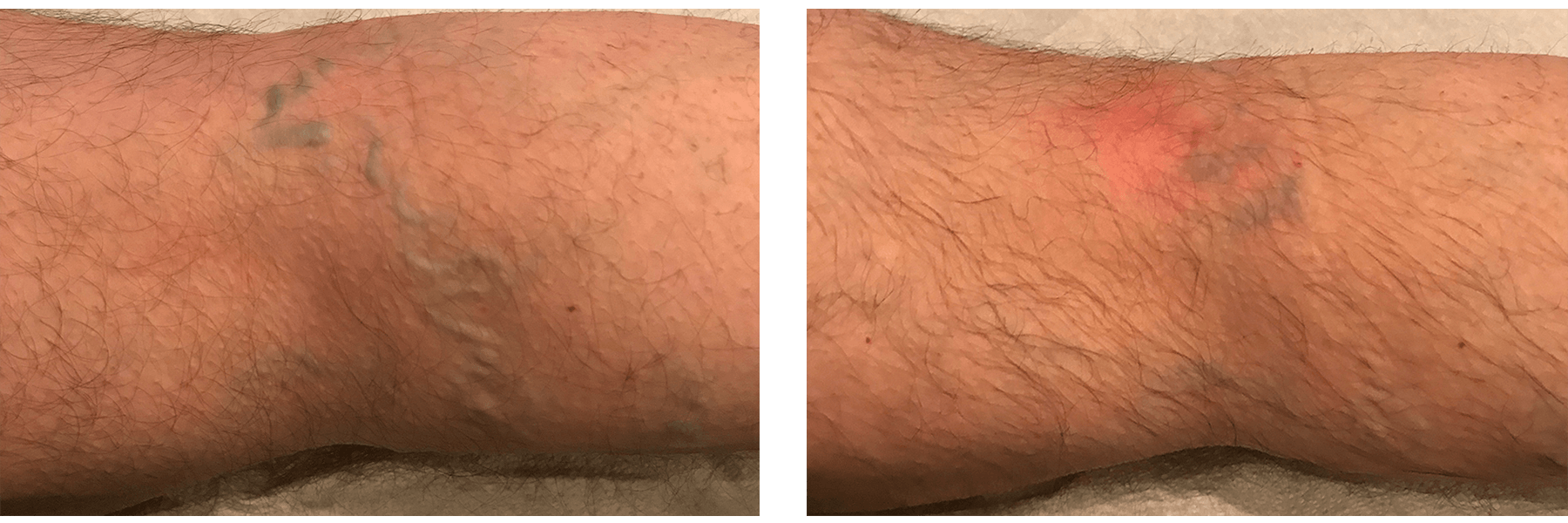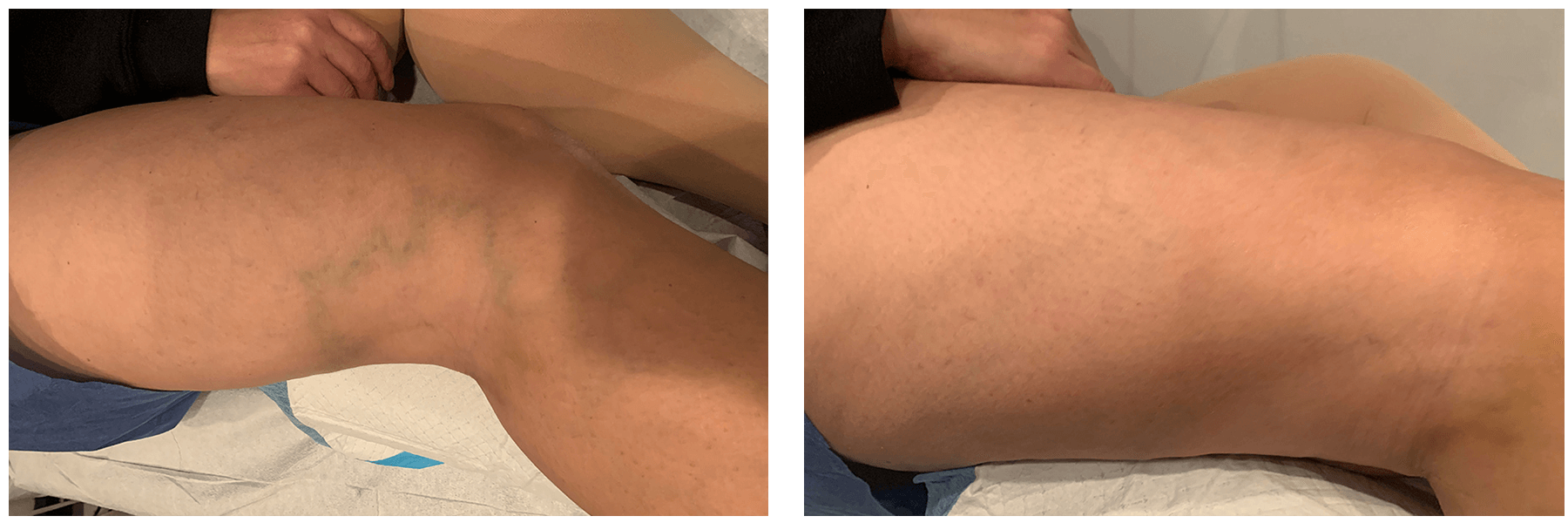Varicose Veins
Varicose Veins and Venous Insufficiency
Varicose veins represent a pathologic condition which results from damage to the tiny valves within the vein walls. Once these valves are damaged, blood can no longer efficiently flow from the foot back to the heart in a normal fashion. This results in blood moving in two directions, often stagnating and not moving well at all. This results in many of the symptoms associated with varicose vein disease.
Varicose veins most commonly develop in the legs and ankles, but can be found elsewhere. They are most common in women, but can be a problem for men as well. Arteries carry blood away from the heart to the rest of the body and the veins are the blood vessels which return blood to the heart. Venous insufficiency results for various reasons. The tiny valves inside veins are damaged and no longer function properly. This results in dilation of the veins, venous hypertension, the signs and symptoms of chronic venous insufficiency, and the appearance of varicose veins.
Common Factors Contributing to Varicose Veins
Heredity – The most common contributing factor is genetic. If your immediate family members have varicose veins, there is a greater chance that you will.
Your Job – Sitting and standing for long periods of time is a huge contributing factor.
Lack of Activity – A sedentary lifestyle with little or no physical activity can be a risk factor.
Female – Women are about 2 – 3 times more at risk than men.
Age – Varicose veins can start to become a problem at age 30, but are most common in those over 50.
Pregnancy – With each pregnancy the risk increases.
Obesity – Obesity puts extra pressure on the veins. Varicose veins are often not visible due to excess fat causing a very late diagnosis and more difficult treatment. High blood pressure can be a contributing factor.
Prior Surgery or Injury – Sometimes normal blood flow can be affected by injury enough to contribute to the development of problem veins.
Symptoms of Varicose Veins and Venous Insufficiency
Symptoms of varicose veins seem to worsen by the end of the day. Some people do not experience symptoms, but many experience one or more of the following:
- Leg fatigue, most common at the end of the day
- Leg aching and pain
- Itchiness or tingling sensation near the veins
- Leg cramps
- Swollen feet and ankles
- A sensation of pressure in the legs
- A feeling of heaviness in the legs
- Dry skin or a thickening and hardening of the skin on legs and ankles
- Skin redness in the area of the ankle and lower leg
- Sores or ulcers on the legs and ankles
- Clusters of veins on the legs
- Swollen veins
- Bulging veins
- Restless legs at night
Diagnosing Varicose Vein Disease
Diagnosing varicose vein disease requires a physical examination of the legs and a reflux ultrasound examination done by a qualified physician and ultrasound technologist.
The ultrasound images identify where the blood in the legs is functioning normally and where some veins might be compromised and require treatment.
Treatment of Varicose Veins
Our vein center offers the newest therapies and procedures developed, revolutionizing the treatment of varicose veins. These minimally invasive techniques are outpatient procedures often performed in less than an hour. All our procedures are safe, proven methods that are highly effective and require very little recovery time. Many procedures, including ultrasound imaging, are covered by health insurance or Medicare.
Your doctor will begin with a physical examination of your legs, together with ultrasound imaging. The ultrasound images identify where the blood flow in your legs is functioning normally, and where some veins may be compromised. Depending on the examination and ultrasound evaluations, the doctor will recommend a treatment plan using the most advanced and effective technologies available.
Before & After Treatment


Varithena
Varithena is an injectable foam therapy approved by the FDA for the treatment of varicose veins. The non-surgical procedure is performed with ultrasound guidance as the doctor injects a micro-foam sclerosant in the vein, displacing the blood and causing the vein to collapse and close.
Varithena treatments can take 30 minutes or less and are often better tolerated than other catheter procedures.
Endovenous Laser Ablation – EVLT
Endovenous Laser Ablation or Endovenous Laser Vein Therapy is also known as EVLT. It is an outpatient, minimally invasive treatment using local anesthesia.
This procedure is performed using ultrasound guidance and is covered by most medical insurance plans.
EVLT is safe. It works using a thin laser fiber inserted into the problem vein, producing heat which causes the damaged vein to close, so your body will reroute blood flow to healthy veins. It provides immediate relief, little or no scarring, and usually takes less than an hour.
Downtime after the procedure is minimal and there are few restrictions during the recovery period.
ClariVein
ClariVein is a highly effective non-thermal treatment for varicose veins. Instead of using a laser and heat to close the vein, a tiny rotating tip is inserted through a catheter into the vein causing micro-scarring inside the vein and dispersing a sclerosant to coat the inside of the targeted vein.
This process seals the targeted vein and has similar successful closure rates as other techniques. Ultrasound guidance is used. The ClariVein procedure is covered by some medical insurance plans and Medicare.
What to Expect After Vein Treatment
Frequently Asked Questions – Varicose Veins
While a lot of people know what varicose veins look like, their causes, natural history, and treatment are relatively unknown to patients, as well as many in the medical community. Dr. Miller would like to present some of the more frequently-asked questions and misconceptions about this common disease.
Click to Expand Each FAQ
Will Varicose Veins Come Back After Treatment?
My mother had varicose veins. Does this mean that i will develop varicose veins?
Many factors play a role in the development of varicose veins; while genetics does indeed have some influence, other factors can lead to their development. Pregnancy, obesity, inactivity, prior surgery, blood clots, trauma, prolonged sitting or standing can all result in the development of this disease.
I have bad varicose veins in my legs and feet. Is there any relationship between this and other vascular diseases, such as hypertension?
Arteries are thick-walled vessels which carry oxygenated blood away from the heart, to all organs and extremities of the body. It accomplishes this under relatively high blood pressures, by way of the fast flowing, muscular arterial system. From here, the blood slows down to a crawl within capillaries, then slowly travels back to the heart by way of the thin-walled, low pressure, slowly-flowing veins.
Veins contain valves, which act as “trap doors” that close to prevent retrograde, or backwards flow of blood. Once the delicate valves are damaged, they no longer close properly, and the blood flows in the wrong direction. Damaged valves result in backward flow of blood, which results in the formation of varicose veins.
Are there any medications or creams that can be used to treat my varicose veins?
In a word, no. Varicose veins are the end result of a biomechanical process, with no current pharmacologic treatment available. Varicose veins can often result in itching and sensitive skin, which may compel the patient to scratch the skin quite often.
Creams and moisturizers can help in relieving the itching sensation, but do not address the disease process. Only catheter-based therapy can successfully treat varicose veins.
I have been hesitant to see a specialist for treatment, as a family member had vein stripping surgery years ago, and subsequently had a long recovery and return of her symptoms several years later. Can any other treatment be offered?
Fortunately, vein stripping is no longer viewed as an effective way to treat patients affected by varicose veins. For the past decade or so, the mainstay of therapy has been catheter-based thermal ablation.
What this means is that a small catheter is placed into the affected vein, which the catheter then heats to the point that the vein actually seals itself closed. Within one hour, patients walk out from this office-based procedure, are encouraged to stay mobile, and return to full activity within several days. Endovascular procedures have truly revolutionized varicose vein treatment.

